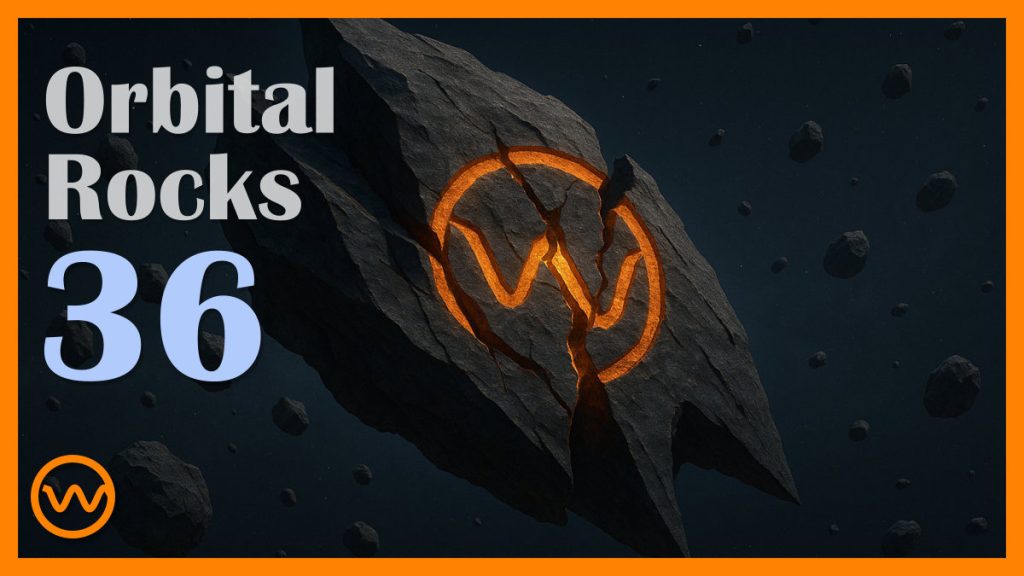ORBITAL WHISPERS
OW36: Orbital Rocks
If your idea of “fun” is orbiting rocks and reused rockets. First up, we’ve got the Moon auditioning for a horror flick, donning a blood-red filter courtesy of Earth’s shadow on September 7. Not satisfied? Cue the telescopes and the inevitable ads: “Buy now, see Luna in Technicolor™! Terms and conditions apply.”
Then there’s asteroid QD8, minding its business, zooming by thrice the distance to the Moon, and we don’t even send it a text to say “Hi.” But hey, at least someone streamed it live. Thanks, Virtual Telescope Project, because we all needed real-time footage of a 200,000-km close shave.
As for rogue interstellar comets like 3I/ATLAS, apparently it’s not enough that we discovered it, we’re now recruiting passing spacecraft for surprise selfies.
The Never Ending Story
The most visible storyline came once AGAIN from SpaceX. In early September, another cluster of Starlink satellites took to the skies. It has become so routine that the spectacle of a Falcon 9 booster landing barely draws gasps anymore. It is becoming more like a late-night TV rerun. The sheer relentlessness of these launches is impressive, but it also feels slightly absurd. 1900 birds this year alone. Like!
Meanwhile, in Ukraine, satellite communications are proving to be more than just a civilian convenience. The United States approved a $150 million extension of services that keep Starlink terminals running. It is no longer possible to ignore that connectivity itself has become a weapon of war. In a conflict where supply chains are fragile and conventional communications are vulnerable, a constellation circling hundreds of kilometers above Earth has become as crucial as artillery or drones. The deal shows how blurred the line between commercial technology and national defense has become.

Back in Washington,
the Air Force signed an $81 million contract with L3Harris to work on multi-orbit connectivity. Unlike Starlink’s single-minded devotion to low Earth orbit, this program focuses on blending GEO, MEO, and LEO into one hybrid capability. It is essentially an effort to build a satellite orchestra where each orbital layer plays a different instrument but somehow produces one coherent tune. The military is clearly betting that diversity of orbits will equal resilience, especially in an era where interference and jamming are not hypothetical threats but daily realities.
The quieter but perhaps more intellectually interesting development came from the academic world. A new proposal for so-called cognitive satellite networks suggests using artificial intelligence to manage spectrum dynamically. Instead of satellites fighting over frequencies like children squabbling over toys, these systems could theoretically negotiate in real time, finding available slices of spectrum and avoiding interference without human regulators micromanaging. The idea sounds elegant, but anyone who has dealt with spectrum politics knows that the technology will be the easy part. Convincing national regulators to loosen their grip will be the real battle, and those institutions tend to move at the pace of glaciers rather than rockets.

Eat, Pray, Love – the Space Edition
The week also offered a reminder that sometimes the most dramatic battles are not fought in orbit but in branding workshops. After last week’s awkward stumble from SES, whose shiny new slogan “Solve. Empower. Soar” was received with the kind of forced applause usually reserved for high school theater, Eutelsat Group decided to quietly polish its own image.
The company has been trying to project confidence after its merger with OneWeb, presenting itself as the newly unified European champion of multi-orbit connectivity. Yet the branding exercise feels a little like an aging rock band changing its name halfway through the tour in hopes the audience will stop noticing the cracks in the vocals. The intent is clear: reassure investors, charm regulators, and make customers believe that the group is not just another GEO operator scrambling for relevance against the Starlink tidal wave. Still, slogans do not erase the reality that Eutelsat’s future depends on whether it can actually knit together its legacy geostationary business with the messy dynamism of OneWeb’s low Earth orbit fleet.
Sidenote: Gottlieb’s Orbital Guillotine
Alan Gottlieb (September 2025 Satellite Mobility World) did not so much critique Eutelsat as slice it open on the page. His September editorial branded the OneWeb merger a “strategic mistake,” noting that the constellation was obsolete before the ink dried. Forty-five ground stations instead of intersatellite links, years of cash burn, and a $1.3 billion French state bailout, hardly the stuff of glossy investor decks. By 2028, when Gen-2 finally staggers online, Starlink, Kuiper, Telesat, and China’s Qianfan will already be handing out capacity like candy.
The real sting is his observation that Eutelsat’s board was dazzled by consultants who “don’t speak satellite.” In Gottlieb’s telling, this was a state-sponsored kamikaze run. The rebranding exercises now look like putting cologne on a corpse.

Taken together, the week revealed the two layers of the satellite world. On the surface we see rockets launching, contracts being signed, and national programs marching forward. Beneath that surface lies the more subtle story of dependence, politics, and risk. Ukraine’s use of commercial constellations is a reminder that private companies can shape the outcome of wars. Europe’s investment in IRIS² is a declaration of political independence dressed in technical language. The United States military’s focus on multi-orbit strategies reflects a deep fear of relying too heavily on a single layer of infrastructure. China’s deployments show the collision between technological ambition and the global commons of astronomy. Even the research on cognitive satellites illustrates that spectrum is as much about power and regulation as it is about algorithms.
By the end of the week, it was clear that the satellite industry is now about end-to-end-sovereignty and survival-of-not-necessaryly-the-fittest. Each orbit represents a political stance. LEO is speed and flexibility, GEO is stability and reach, MEO is compromise and balance. The actors that can weave those layers together will likely control the strategic future of connectivity.
So, as of September 5, the play continues. SpaceX keeps churning out satellites like a factory that never sleeps. Ukraine clings to its orbital lifeline. Europe sharpens its institutional knives to carve out autonomy. The U.S. military doubles down on diversification. Researchers dream of cognitive algorithms that may or may not ever escape the laboratory. And the rest of us watch, shaking our heads at the sheer absurdity of how quickly the heavens have turned into a boardroom and a battlefield.
The future will be crowded, contested, and strangely beautiful.


Leave a Reply
Please log in to comment.